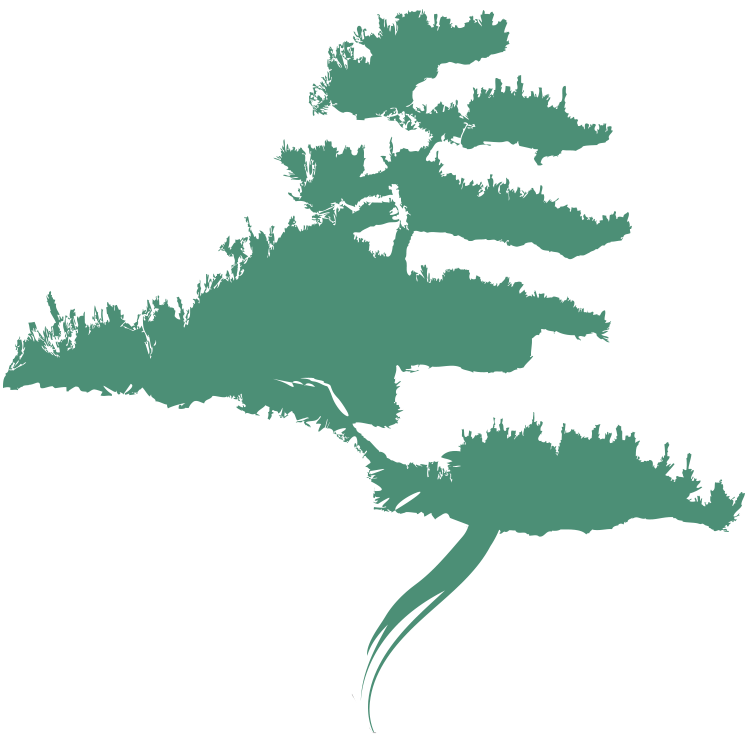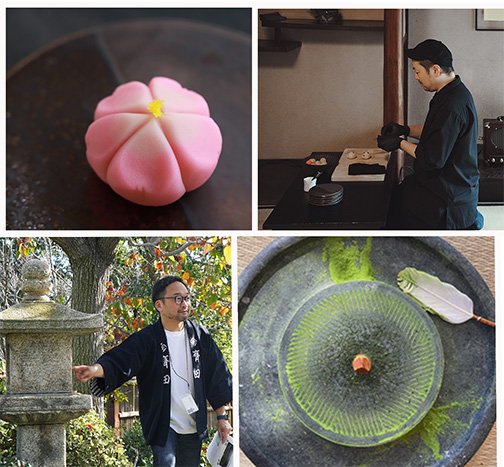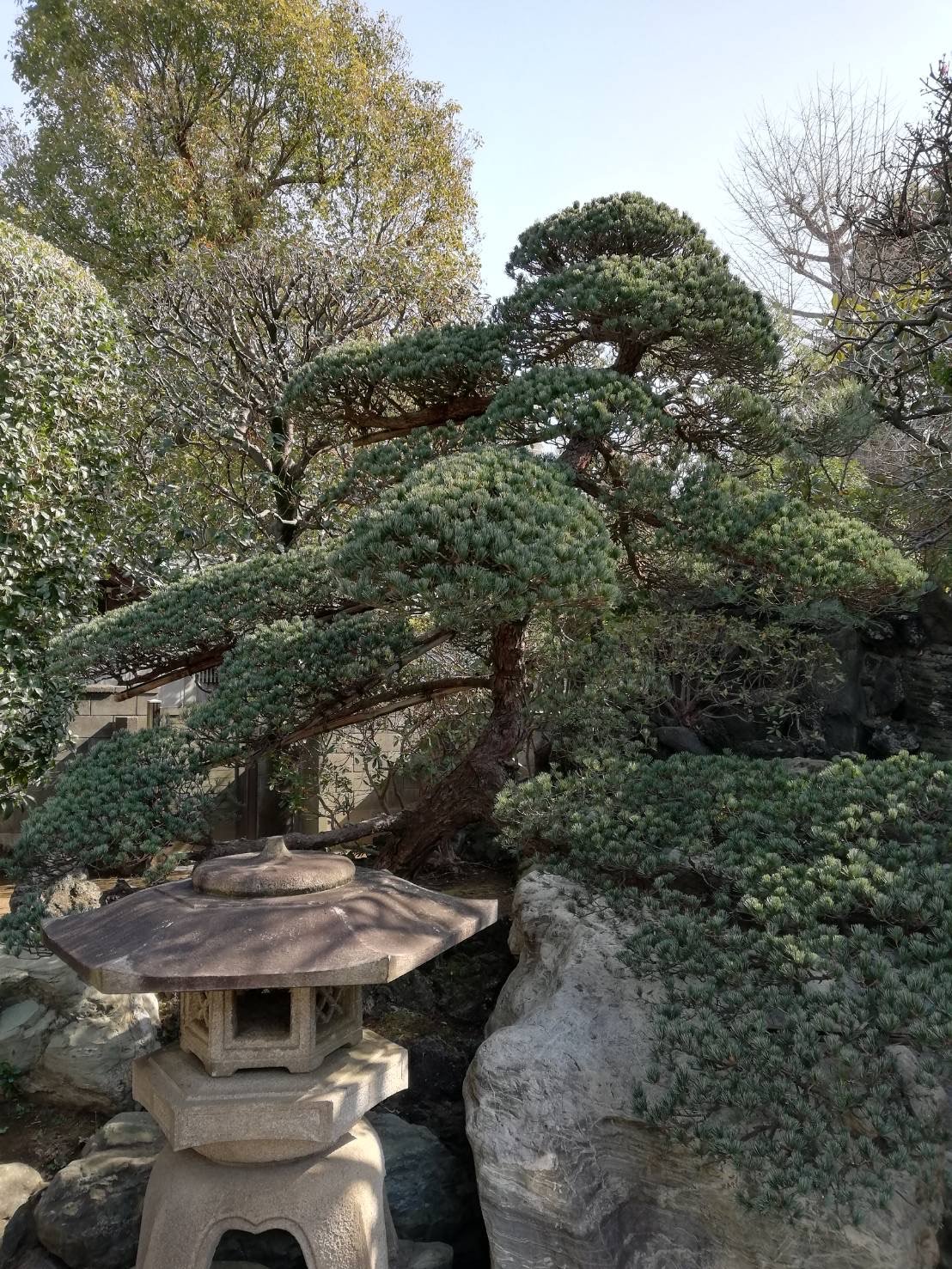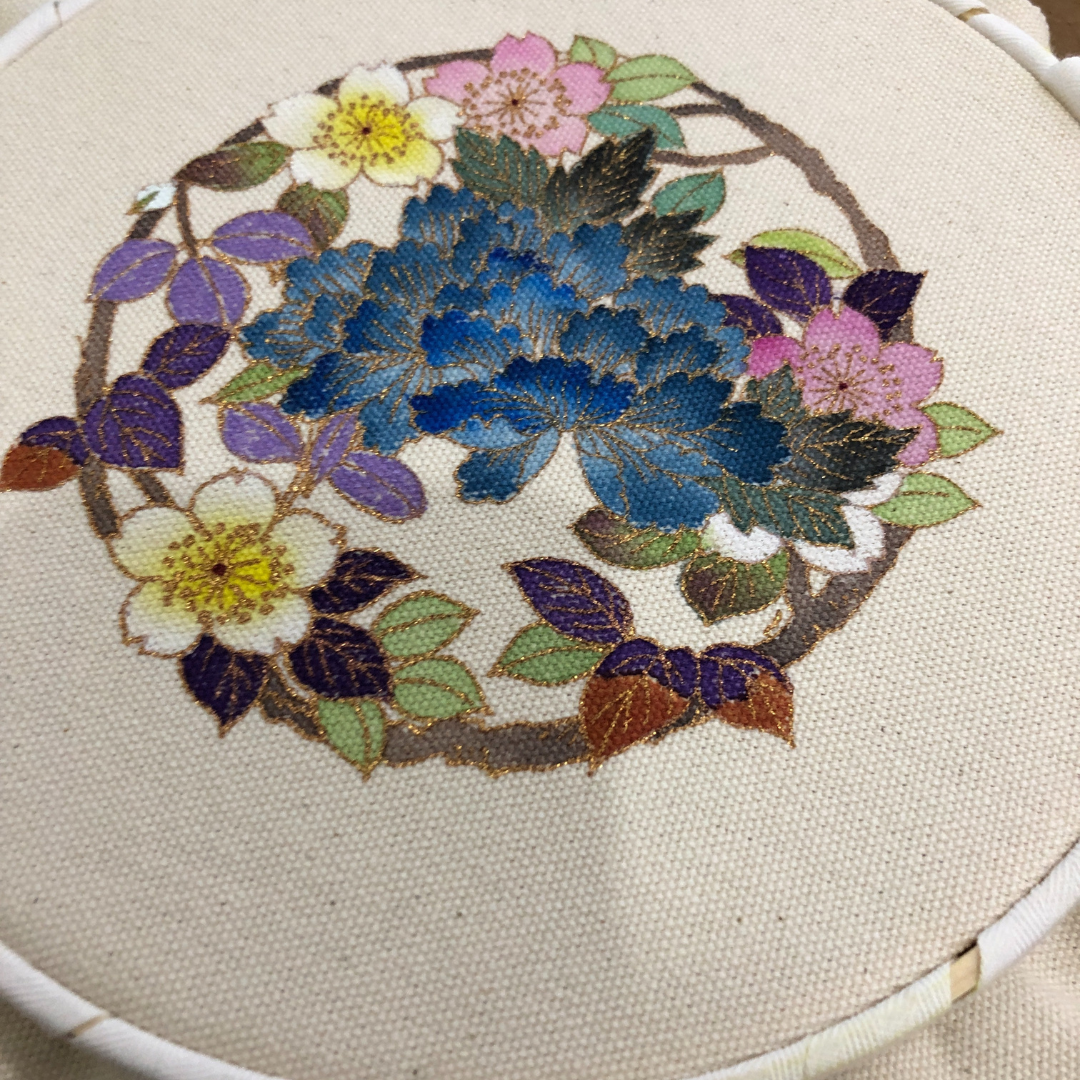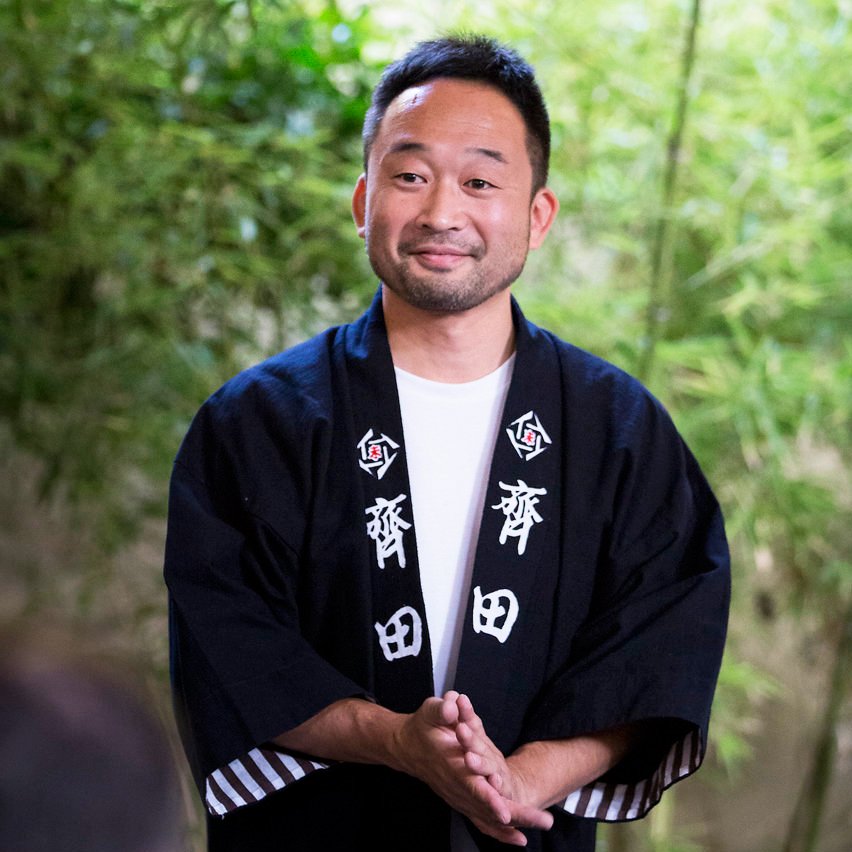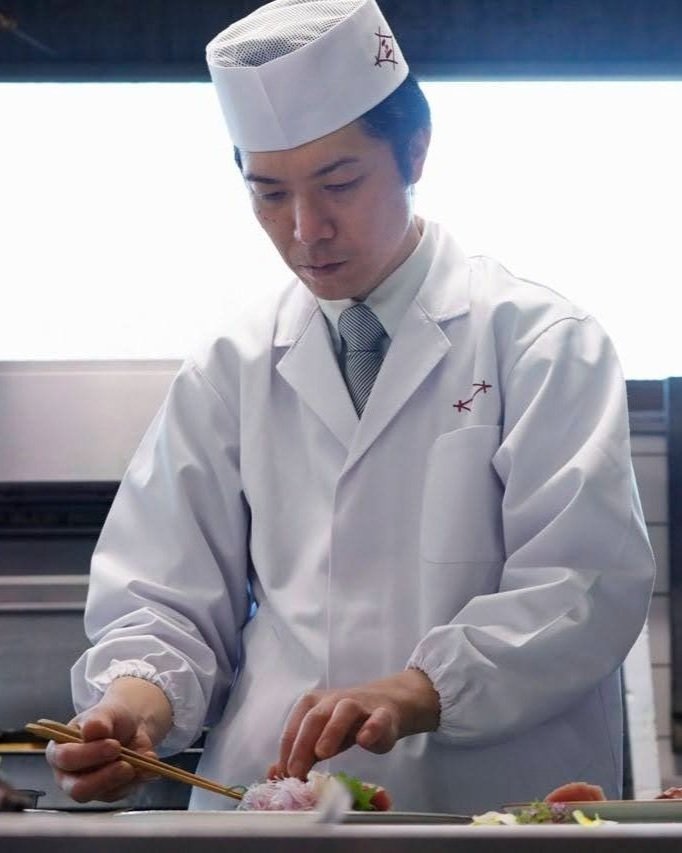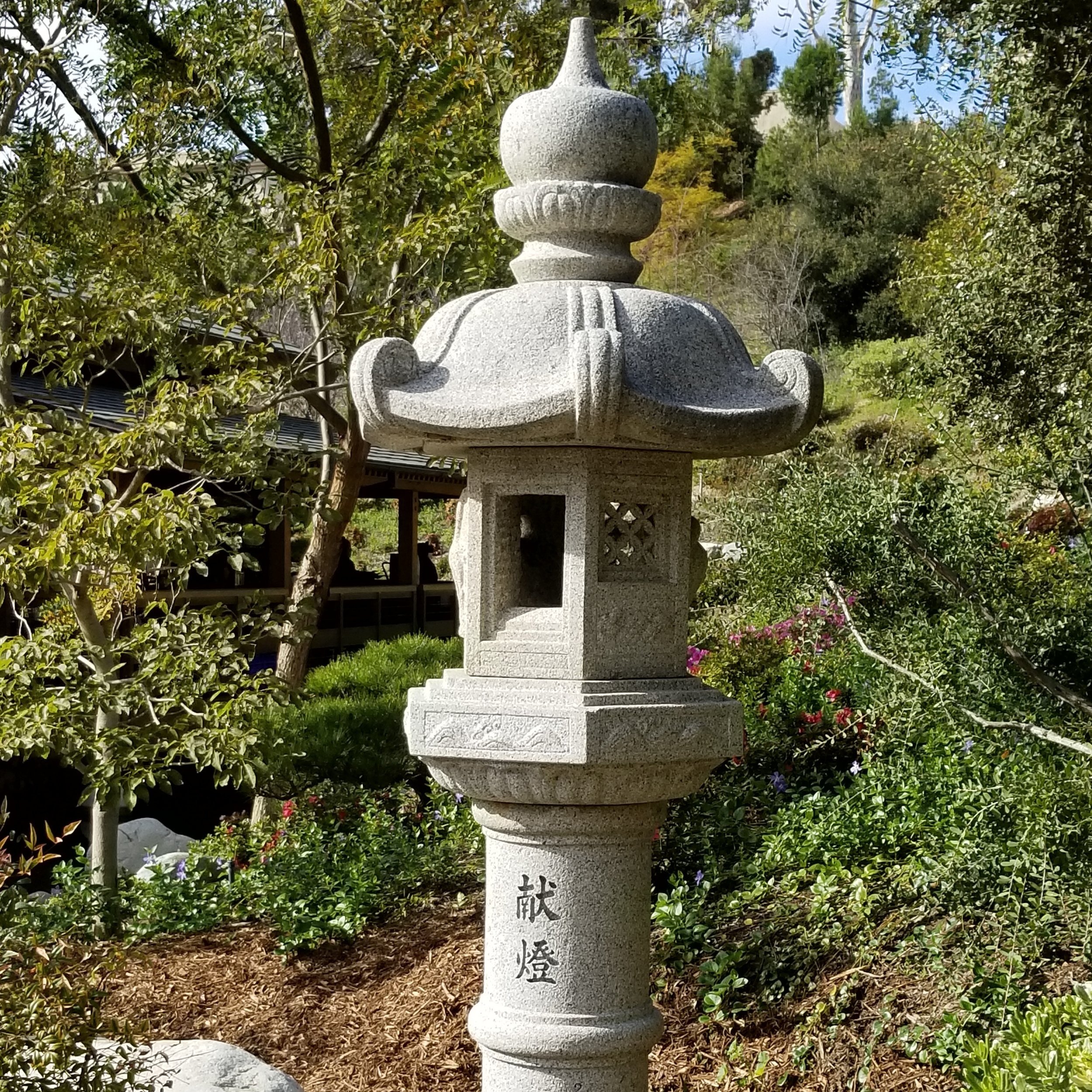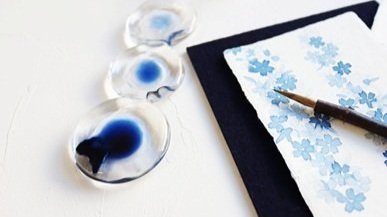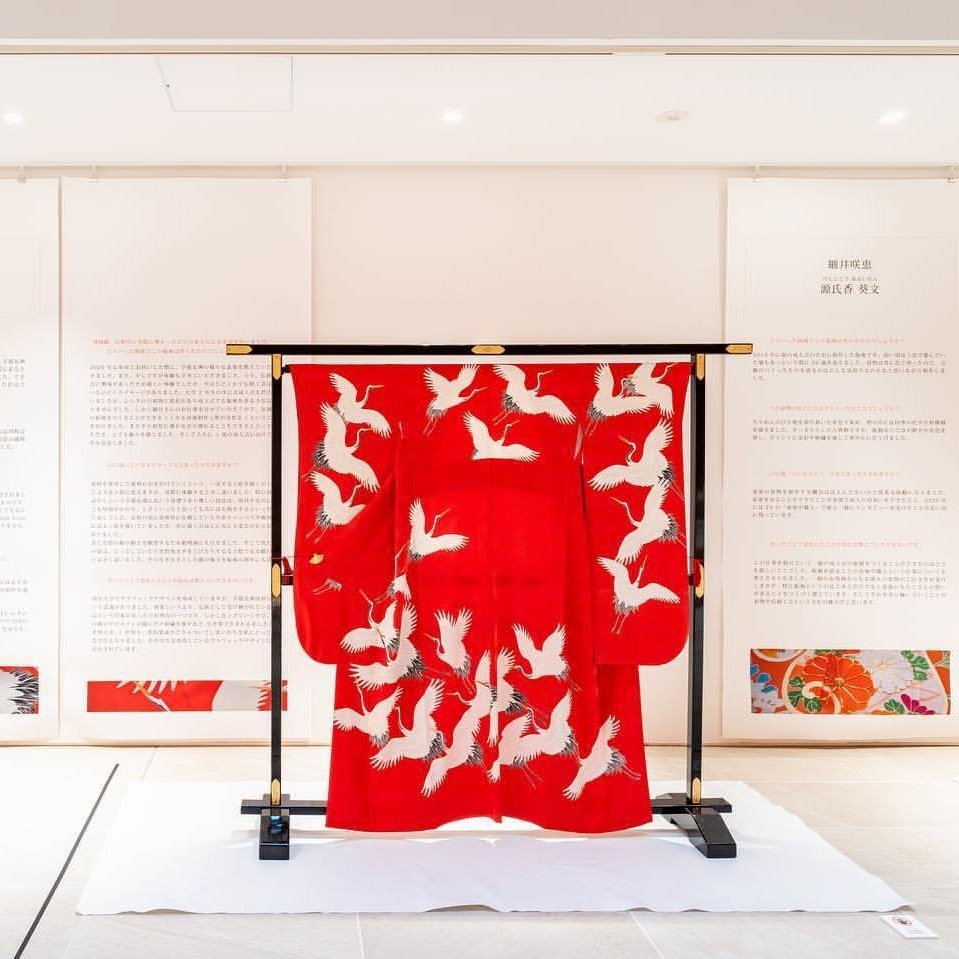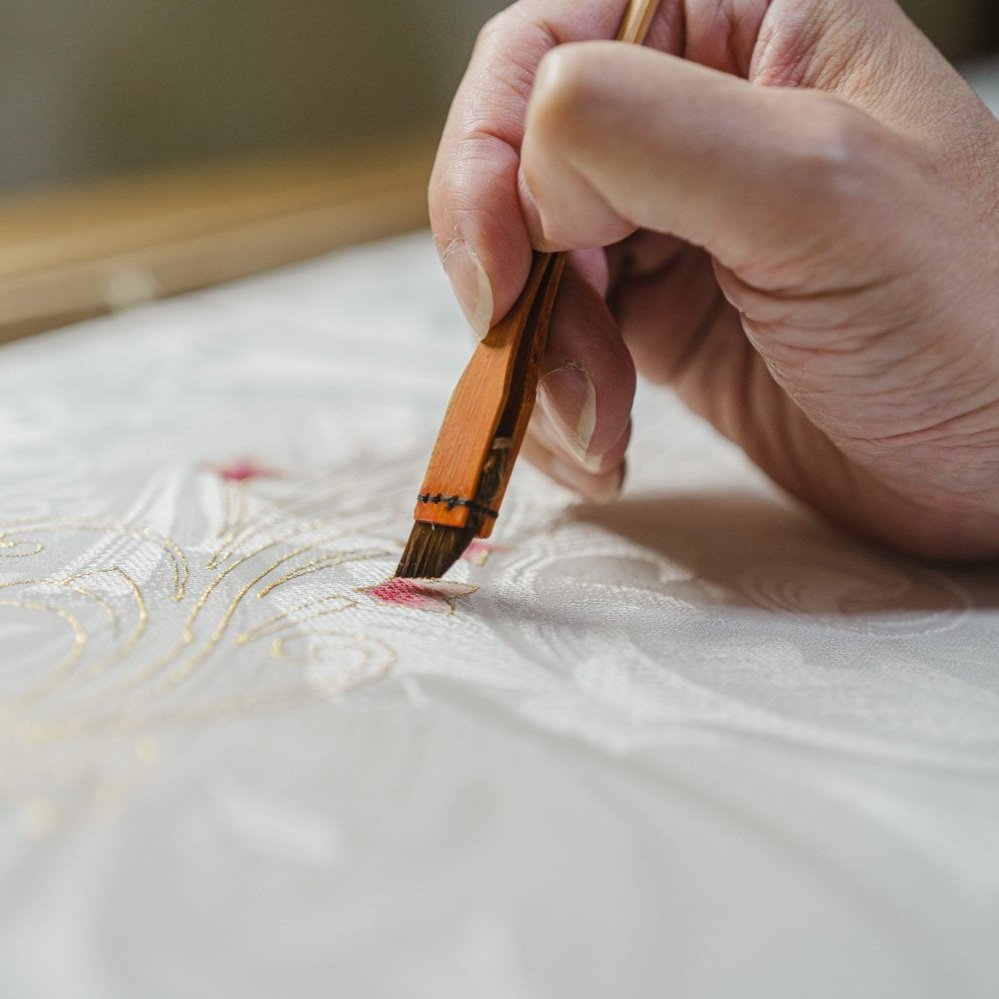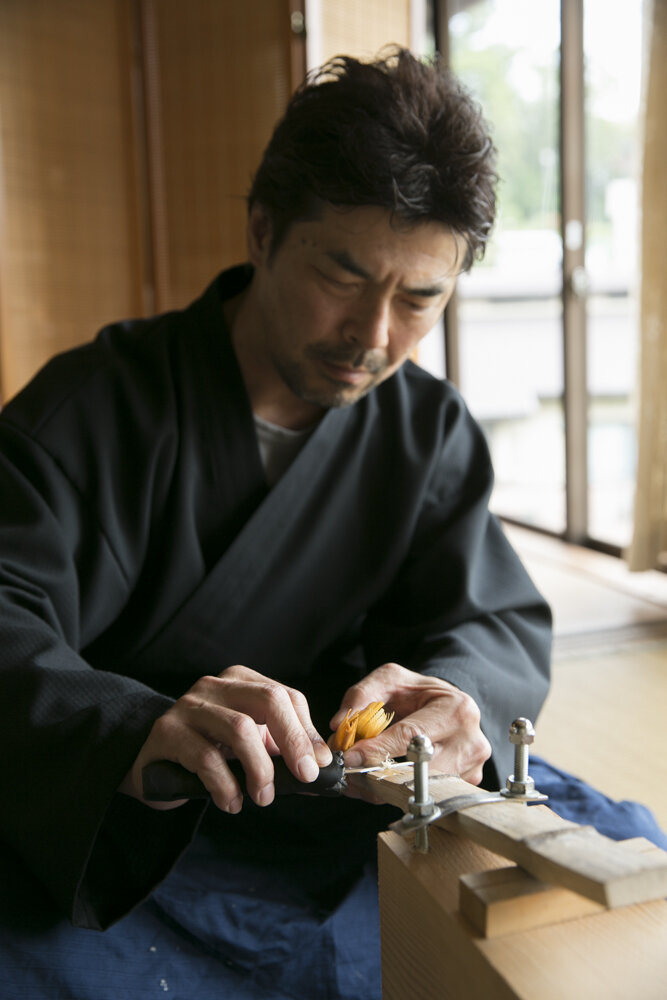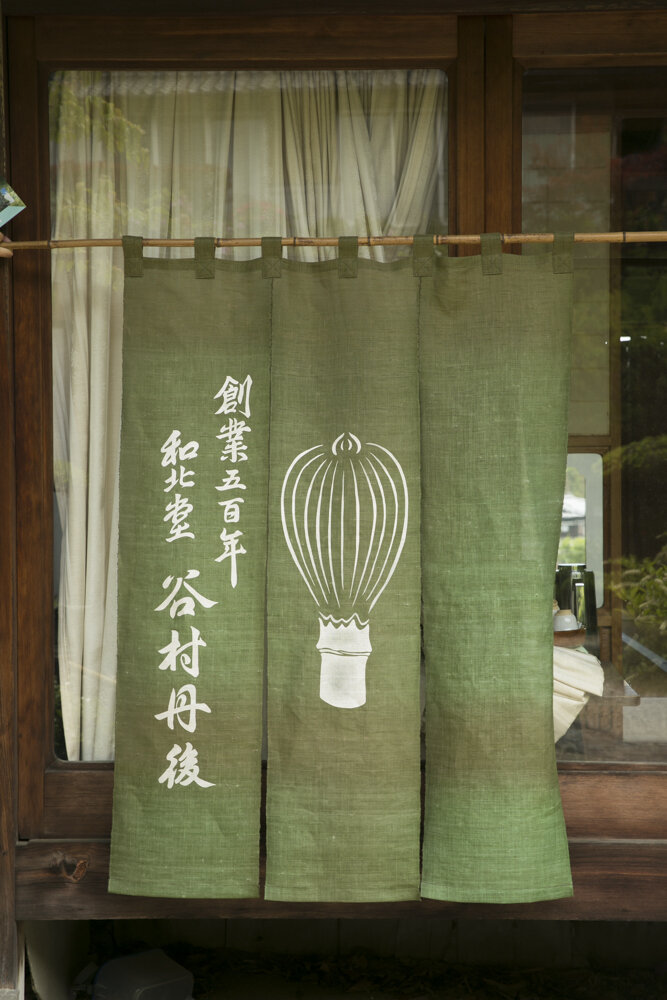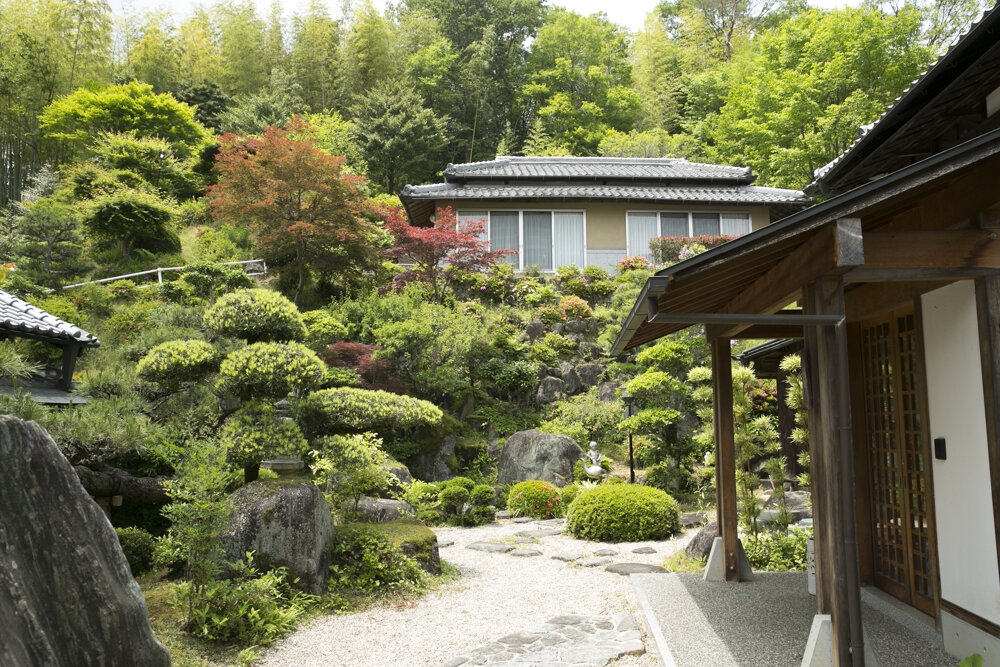MASTER SERIES PROGRAM
Introducing JFGM’s Master Series Program featuring master artisans from Japan and San Diego. Participants will learn various techniques and basic understanding of bamboo making, lacquer, stone lantern, tea whisk, and much more. The Master Series Program provides valuable cultural enrichment emphasizing the Japanese cultural heritage as well as everyday life in Japan and how these practices have reached beyond Japan.
Up Coming
Master Series: Experience Japanese Tradition; Wagashi making and Matcha Grinding workshop (In person)
Join us for a hands-on cultural experience with two master artisans from Kyoto. Wataru Kanaya, sixth-generation confectioner of Kyogashi Kanaya Masahiro—a traditional Japanese confectionery shop founded in 1856—will guide participants in creating nerikiri, delicate confections made from sweet bean paste and Mochiko rice flour. Shaped by hand and inspired by the seasons, these sweets are beloved in the Japanese tea ceremony. Takaaki Saida, fifth-generation stone smith, will demonstrate grinding tencha (green tea leaves) into fine matcha using a hand-carved stone mill.
past event
Master Series: Stone Mill Demonstration & Lantern Tour
Sunday, May 18
Takaaki Saida, a fifth-generation stone smith and artist from Kyoto, Japan. Since 1902, the Saida family has specialized in traditional stone processing and sculpture. Mr. Saida brings this legacy to life by demonstrating the ancient method of grinding tencha (green tea leaves) into fine matcha powder using a hand-hewn stone mill.
Woven Heritage: Kitamura Tokusai IX and Tea demonstration
Sunday, April 20
Kitamura Tokusai’s family has been designing and making silk textiles, or fukusa, for practitioners of tea since 1712. Their inventory of fabrics feature over 400 patterns of historical significance, many of which were expressly favored by the founders and most prominent devotees of Japan’s tea culture.
Fuki Urushi /Wiped Lacquer Experience: Applying lacquer to a wooden bowl and chopstick.
January 24, 2025
People have been using "urushi," a natural tree sap, for over 10,000 years to coat wood for protection and as an adhesive. Urushi possesses chemical properties such as water resistance and antibacterial effects, making it an ideal natural lacquer for preserving and prolonging the life of objects.
Authentic Urushi Kintsugi experience, drawing lines with lacquer and sprinkling gold powder.
January 25, 2025
Kintsugi goes beyond mere restoration; it embodies profound cultural and spiritual significance. It symbolizes a value of cherishing objects—not discarding them when broken, but repairing and continuing to use them. This philosophy aligns with sustainable living and the Japanese tradition of fostering long-lasting relationships with possessions.
Black Pine Pruning Class
October 5, 2024
In this program, Japanese Master Gardener Manabu Katayama of Yokohama, Japan, will discuss the maintenance and management of Japanese black pine. The program will include demonstrations, garden tours, printed materials, lectures, Q&A sessions, and participants will also have hands-on opportunities to experience pruning
Manabu Katayama
Manabu Katayama has been a Japanese Gardener for 22 years in Yokohama, Kanagawa. During his career as a gardener, he learned from his masters and traveled domestically to learn from other gardens. His pine style is called "Tanyou hou" (short leaves) which are Adachi Museum in Shimane prefecture and more. He currently takes care of private gardens, but black pines are his specialty.
Stone Tea Light Candle Holder
October 26, 2024 by Instructor, Taka Saida
In this workshop, master stone smith Taka Saida will introduce the flea finishing technique applied to Kyoto stone style lanterns. Flea finishing is a traditional techniques that is unique to Kyoto, such as weathering the lanterns to give them a dignified appearance that changes with age. After the short lecture, participants will have the opportunity to finish their own stone tea light candle holder to be taken home.
Learning Sudare
June 25, 2024
Kyo-sudare is a bamboo blind that combines both functionality and elegance. Kyo-sudare Kawasaki procures more than 15 varieties of materials from Japan and other countries. They produce bamboo blinds for outdoor and indoor use, tatami rooms, yoshi-do (summer sliding doors), and other miscellaneous goods. The company also produces interior fittings, sundry goods, and bamboo blinds for sushi rolls. Reed is a raw material that purifies water and plays a role in preserving a beautiful environment. Additionally, Kyo-sudare Kawasaki repairs their products so that blinds made 50 years ago can be revived for another 50 years. By preserving the culture of the bamboo blind, Kyo-sudare Kawasaki makes it possible to manufacture in a more environmentally friendly and sustainable manner
Kyo Wagashi lecturE
February 27, 2024
In 1995, Kyoto Confectionery Fujikou was established in Kameoka City, Kyoto Prefecture. Based on the concept of "local production with local water," they make confections that take full advantage of the flavors of locally harvested ingredients. Kyoto Tamba has been long called "Kyoto's Kitchen" because of the abundance of crops grown there. The fog that forms in late autumn and the clay soil nurture large, high-quality ingredients. Tanba dainagon azuki beans, Tanba black beans, and Tanba chestnuts were historically brought to the capital as gifts, and are now used in Kyoto cuisine as top-quality ingredients.
Japanese Cultural Experiences through Kyoto Cuisine & Craftsmanship
January 25-28, 2024
Chef Ozasa and Chef Kimura
Participants can experience the relationship between Kyoto's food culture and traditional crafts through cha kaiseki. Cha kaiseki cuisine is the practice of serving multi-dish meals during a tea ceremony. The method incorporates the use of seasonal ingredients and flavors to serve the guests. Kyoto food culture heavily involves Kyoto style dashi broth, a soup stock made from kombu and dried bonito flakes.
Kintsugi Hybrid Workshop
January 23, 2024
Instructor: Takuya Tsutsumi (https://www.kourin-urushi.com/)
Kintsugi is a traditional technique of restoration, using urushi (the sap of the lacquer tree ) and gold. Not only does it repair the item, it also serves as a bridge to pass on the feelings and history of the past, as well as to connect the heart to the future. Tatsuya Tsutsumi is a fourth generation of a lacquer refiner who has been in business since the Meiji era. He started "Urushi no Ippo" as an initiative to connect the next generation of children to a lifestyle with lacquer, and is working to pass on lacquer, a sustainable natural material that has been used in the Japanese climate for 10,000 years, to the next generation.
Yuzen Hybrid Workshop
January 25, 2024
Instructor: Sachi Manabe/Morphoshere ( https://kyoto.travel/fr/people/sachimanabe.html)
The Yuzen technique, which involves painting dye directly onto cloth, was invented in the 17th century during the Edo period in Japan. This art of dyeing kimonos has become renowned for the distinctive and vivid colors only be found in Japan.
Stone Lantern Tour
January 27, 2024
Instructor: Taka Saida
Japanese stone lanterns were adopted by masters of the Japanese way of tea who included them in tea gardens to help guide the pathways. Initially being accessible by the wealthy, they were eventually adopted not just as votive lights, but also as more practical lanterns to light the precincts of shrines and temples. Taka Saida is a 5th generation stone smith who will discuss the use of stone lanterns in Japanese gardens.
Tanzan Sake Brewing online Tour and Lecture November 6, 2023
Instructor: Nagisa Hasegawa (5th generation) head of Tanzan Brewery
Tanzan Sake Brewing was established in 1882 and located Kameoka, Kyoto. Based on the principle that “sake brewing starts with rice cultivation and rice cultivation starts with the soil,” the brewery grows Yamada-Nishiki sake rice in the rich soil of Kameoka, Kyoto, upstream from Arashiyama, using natural farming methods. Of the five wells in the brewery, two are used forbrewing. Only the best water is used for sake brewing. The use of soft water gives the sake a mild taste, and the brewery currently produces about 25 different kinds of sake, with about 20 brands on sale at any given time.
Shimenawa Wreath Making November 11, 2023
Instructors : Masashi and Naomi Kitamura
Shimenawa ropes are used to mark sacred places and objects, and they are found at Shinto shrines, torii gates, trees, and landmark rocks in Japan. Traditionally used in Shinto rituals and other ceremonies, these ropes are often seen festooned with shide, Japanese washi paper folded into zigzag shapes, representing lighting to keep evil spirits away and bring rain and good harvest. Both Shimenawa and shide are common parts of New Year decorations in Japan. All materials included. Please note that decorative items may vary
Stone Lantern Walk Tour
October 11, 2023
speaker: Stone Master, Taka Saida
Japanese stone lanterns were adopted by masters of the Japanese way of tea who included them in tea gardens to help guide the pathways. Initially being accessible by the wealthy, they were eventually adopted not just as votive lights, but also as more practical lanterns to light the precincts of shrines and temples. Taka Saida is a 5th generation stone smith who will discuss the use of stone lanterns in Japanese gardens.
Kyoto Cuisine and craft in Kyoto
October 10, 2023
speaker: Taka Saida Chef: Masayoshi Ozasa
Chef Ozasa prepared small bites to enjoy during Mr. Saida’s presentation; The remarkable journey of contemporary Japanese craftsmen who preserve tradition, while also forging new artistic paths in Kyoto. There was a small showcase featuring exquisite works by Kyoto craftsmen. Kyoto based Linked Artisan Association introduces Kyoto Cuisine and craft in the Japanese Friendship Garden and Museum.
Lantern walk tour with Stone Master Taka Saida May 19, 2023
Japanese stone lanterns were adopted by masters of the Japanese way of tea who included them in tea gardens to help guide the pathways. Initially being accessible by the wealthy, they were eventually adopted not just as votive lights, but also as more practical lanterns to light the precincts of shrines and temples. Taka Saida is a 5th generation stone smith who will discuss the use of stone lanterns in Japanese gardens.
The Blue Path: Experience of hand brushed Kyo Yuzen May 19, 2023
Traditional hand-painted yuzen is done under a division of labor system. In the original production process, Tsuyukusa(Asiatic dayflower, which is used as underpainting in the process, is used as ink to color the postcards with Kyoto Yuzen patterns. Anna Namikawa (Harvest Journey Kameoka) provide the lecture of the Kyo Yuzen and navigate the event.
Wagashi Lecture & Higashi Making By Ayumi Uehara April 13, 2023
The workshop included a lecture on the history of wasanbon and the now rare confectionery wooden molds. Participants were able to actually use the wooden sweets molds to make a piece of wasanbon dried confectionery. Instructor Ayumi Uehara's father, Yoshihiro Ichihara, is a qualified traditional confectionery mold maker. While growing up in a family that made confectionery molds, after seven years of working for a company unrelated to the business she opened the Japanese confectionery salon "Mamehana" in 2009 to promote confectionery molds and Japanese sweets. She is active in her hometown of Takamatsu City, Kagawa Prefecture, and holds workshops throughout Japan and even overseas.
Kyo Yuzen By Satoshi Hosoi February 23, 2023
Kyo-yuzen is a dyeing technique that creates colorful, pictorial patterns on kimono. This technique was based on dyeing methods developed by the Edo period (1603-1868), and was established as hand-painted yuzen by Miyazaki Yuzenzai, a fan painter living in the Gion, area of Kyoto during 17th centuries, who added beautiful and gorgeous paintings to the technique. The dyeing method is very unique as artisans put glue around the outlines of the patterns to prevent the color from running and getting mixed up with the other patterns. Since this traditional handwork is an intensive and expensive labor.
Raku ware Master Potter: Kyoshitsu Sasaki/ Shoraku Kiln (Virtual) June 30, 2022 Raku ware Pottery born from the Japanese tea ceremonies. This Master Series will cover its history, progress, and present.
Shorakugama (Shoraku kiln) The kiln has changed the name to “Kiraigama” kiln when it was moved to a mountain of Kameoka, the north side of Kyoto. The history of the kiln has been developing for approximately 10 decades with thoughts and skills from Kichinosuke Sasaki, the founder of Shorakugama kiln.
Stone Lanterns & Mills by Taka Saida April 3, 2022
This workshop discussed the use of stone lanterns in Japanese Gardens, as well as hand shaped stone mills used for matcha making. Mr. Saida demonstrated and introduced his hand hewn stone tea mill. Guests used the resulting fresh matcha to drink a cup of tea as well as eat a traditional Japanese sweet .
Ichiju Sansai ( One soup and three dishes ) by Masayoshi Ozasa March 17, 2022
Kyoto Style Japanese Cuisine Cooking Class
After graduating from Kyoto Culinary Art College, Masayoshi Ozasa trained for three years at Kinobu in Shimogyo-ku, Kyoto to then become a young master at his family's restaurant. "Matsusho", established in 1936, using characteristics of the Tamba region, which is rich in food ingredients to create "Kyoto cuisine that cannot be found in the center of Kyoto".
Stone Lanterns & Mills by Taka Saida November 2, 2021
This workshop will discuss the use of stone lanterns in Japanese Gardens, as well as hand shaped stone mills used for matcha making. Mr. Saida will demonstrate and introduce his hand hewn stone tea mill. Guests will use the resulting fresh matcha to drink a cup of tea as well as eat a traditional Japanese sweet .
Ikebana International - San Diego Chapter
Ellen Sakagawa - Ikenobo School
Originally recorded and scheduled on September 16, 2020
Ikebana International (I.I.) is a worldwide organization founded in Tokyo, Japan, in 1956 by the late Ellen Gordon Allen. Its members are dedicated to promoting the mutual understanding and friendship between Japan and other countries through ikebana (the art of Japanese flower arrangement) and other related arts of Japan. I.I. is a non-profit cultural organization in Japan, and today boasts over 10,000 members with chapters in more than 50 countries where some stress classic styles; others focus on creative, contemporary styles; and others blend the two forms. ikebanasandiego.org
—-
Matcha Tea Whisks by Tanimura Tango
Originally scheduled on September 24, 2020
For more information on Tanimura-san, visit tango-tanimura.com/en/
Learn about the centuries-old technique of making matcha tea whisks from master craftsman Tanimura Tango. He is the 20th generation descendant of a family that has been making bamboo chasen (tea whisks) for the past 500 years in Takayama, located in the Nara prefecture. Until the end of the Meiji era (1868-1912), the method of making the chasen was kept secret and only passed on to the eldest son among the families of chasen makers. Each tea whisk is handmade from a single piece of bamboo with over 100 types and forms to meet the exact requirements of different tea schools.
—-
Japanese Tea (Fukamushi)
Okabe Takahiro and Sho Honma
Originally recorded and scheduled on October 15, 2020
Minami Shinagawa chabako owner, Okabe Takahiro, grew up learning tea ceremony. Later, he would hold an event for Japanese tea to promote business for Kakegawa tea. When opening Tea of the Men, LLC, Takahiro would only serve one kind of Japanese tea: deep-steamed green tea. Here, he discovered that the best way to make Japanese tea depends on the type being served and went to learn from tea farmers and sellers and practice serving tea until they approved. facebook.com/cha8ko
—-
Ikebana International - San Diego Chapter
Akiko Bourland - Ohara School
October 2020
Ikebana International (I.I.) is a worldwide organization founded in Tokyo, Japan, in 1956 by the late Ellen Gordon Allen. Its members are dedicated to promoting the mutual understanding and friendship between Japan and other countries through ikebana (the art of Japanese flower arrangement) and other related arts of Japan. I.I. is a non-profit cultural organization in Japan, and today boasts over 10,000 members with chapters in more than 50 countries where some stress classic styles; others focus on creative, contemporary styles; and others blend the two forms. ikebanasandiego.org
—-
Stone Lanterns and Japanese Gardens w/ Saida Taka
Originally recorded and scheduled October 2020
Japanese stone lanterns were adopted by masters of the Japanese way of tea who included them in tea gardens to help guide the pathways. Initially being accessible by the wealthy, they were eventually adopted not just as votive lights, but also as more practical lanterns to light the precincts of shrines and temples. Taka Saida is a 5th generation stone smith who will discuss the use of stone lanterns in Japanese gardens. saidasekizai.com
—-
Ikebana International - San Diego Chapter
Debbie Warriner - Ichiyo School
Originally recorded and scheduled November 2020
Ikebana International (I.I.) is a worldwide organization founded in Tokyo, Japan, in 1956 by the late Ellen Gordon Allen. Its members are dedicated to promoting the mutual understanding and friendship between Japan and other countries through ikebana (the art of Japanese flower arrangement) and other related arts of Japan. I.I. is a non-profit cultural organization in Japan, and today boasts over 10,000 members with chapters in more than 50 countries where some stress classic styles; others focus on creative, contemporary styles; and others blend the two forms. ikebanasandiego.org
—-
Bamboo Fencing w/ Mashimo Akihiro
Originally recorded and scheduled November 2020
Akihiro Mashimo was born in 1977 in Yokohama. He moved to Nagaokakyo City in Kyoto at the age of five, where he grew up around bamboo. He learned bamboo craftwork at the Traditional Arts School of Kyoto and then entered Nagaokameichiku Co., Ltd. in 1998 after his graduation. Afterwards, he studied under his teacher Ichiro Mishima (a recipient of the Kyoto Prefecture Traditional Industry Excellent Craftsman Award) and made bamboo fences. His major works are found at the Katsura Imperial Villa, Kyoto State Guest House, Kashiharajingu shrine, and Heian Jingu Shrine. He was recognized as a Certified Kyoto Traditional Products Craftsman by the governor of Kyoto Prefecture in March 2015. nagaokameichiku.com
—-
Japanese Lacquer w/ Wakashima Hidetaka
Originally recorded and scheduled November 2020
Japanese lacquer is an organic substance made from the sap of the urushi tree (Rhus verniciflua) after scratching it off the tree, refined, and then aged. Hidetaka Wakashima started learning lacquer techniques from his father, Takao Wakashima, participate in group exhibitions (2005, Pola Museum, Tokyo), which led to the creation of his own brand Rokuzo in 2006 where he continues to explore new ways of creating lacquerware. Wakashima-san’s hometown of Wajima is known for its unique lacquerware product, wajima-nuri. The unique characteristic of wajima-nuri is the use of Wajima jinoko — a high quality clay that is used as a base for lacquerware making it possible to create stronger lacquerware.
—-
San Diego Bonsai Club
Originally livestreamed December 2020
The San Diego Bonsai Club (SDBC) is one of the oldest clubs in the state of California. It was founded in 1965 as a non-profit California 501(c)(3) organization and provides their members with a forum to exchange information, learn, teach and promote the art of bonsai through lectures, classes, workshops, demonstrations, field trips. SDBC is open to anyone who shares this enthusiasm or just wants to try their hand at it. sandiegobonsaiclub.com
—-
Koi Club of San Diego
Originally livestreamed December 2020
In 1984 a few koi hobbyists in San Diego came together to form an organization based on their shared enjoyment of these beautiful fish. Since that time the club has grown to over 120 families and our mission has evolved to include education of our members and the public on all aspects of koi keeping, to promote the koi hobby, and to become a part of the larger community of koi enthusiasts throughout the country and the world. koiclubofsandiego.org
—-
This program is made possible thanks to the Japan Foundation Center for Global Partnership.
“Today, Japan and the United States enjoy a very close relationship, encompassing a diverse array of fields. In fact, forging and strengthening connections and networks through exchange is the most important mission of the Japan Foundation. In this light, the Foundation supports fundamental infrastructure that allows these connections to develop and implements various programs to foster exchange and build networks. We work with both institutions and individuals, and those partners include universities, think tanks, museums, Japan-America societies, U.S. JET Alumni Association, the North American Japanese Garden Association, as well as professionals from a broad spectrum of backgrounds, including academics, practitioners, educators, artists, and curators.”
